|
|
|
Sort Order |
|
|
|
Items / Page
|
|
|
|
|
|
|
| Srl | Item |
| 1 |
ID:
137211
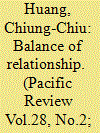

|
|
|
|
|
| Summary/Abstract |
Although many observers in the field of Southeast Asian international relations (IRs) predict that Myanmar's relations with China have faced a grand challenge since the 2010 presidential election, this article provides a different perspective and proposes that Myanmar's China policy remain consistent. In addition, theorists in IRs tend to apply the concepts of balance of power (BoP) and bandwagoning as the analytical base and fail to explain the Southeast Asian states’ responses to the rising China. This article argues that Myanmar's China policy is better understood and depicted by the theory of balance of relationship (BoR). This article further provides an analysis from the angles of historical factor, domestic political tradition, and external environment to investigate Myanmar's manipulation of BoR. The conclusion of this article aims at predicting the future development of the Sino-Burmese relations.
|
|
|
|
|
|
|
|
|
|
|
|
|
|
|
|
| 2 |
ID:
137216


|
|
|
|
|
| Summary/Abstract |
The nature of food risk in Japan has undergone a qualitative change in recent years. This article synthesises insights from psychology, economics, and political science into an interdisciplinary risk approach to show how international relations impact consumer decisions in Japan by outlining how food risks are constructed and framed within existing narrative frameworks. To this end, the article employs two case studies: the gyōza incident in 2008, when poisoned dumplings imported from China caused ten people to fall ill, and contaminated beef incident in 2011, in which five people died and dozens more were hospitalised after consuming raw beef tainted due to industrial negligence. These cases are analysed in the context of Japan's low rate of food self-sufficiency, deteriorating Sino-Japanese relations and the ‘China threat theory’, and perceptions of food safety. The article shows how, despite suffering recent major domestic food contamination incidents and lethal domestic food terrorism, Japanese food is perceived as safe and healthy whereas imported food, and especially Chinese food, is perceived as dangerous and unhealthy. This is exemplified in the domestic response to the two cases: the gyōza incident led to a national outcry, mass hysteria, and calls for a ban on Chinese food imports. Conversely, the raw beef contamination incident – the deadliest case of food contamination in Japan since the 1990s – saw a far more mixed response, as industry, media, and consumers called for the government to allow individuals to take on self-responsibility to mediate their own risks regarding (domestically produced Japanese) food. The article concludes by pointing out that, while behavioural sciences can tell us important things about risk, the political and international context must also be considered.
|
|
|
|
|
|
|
|
|
|
|
|
|
|
|
|
| 3 |
ID:
137212
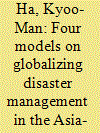

|
|
|
|
|
| Summary/Abstract |
This study contributes to disaster management in the Asia-Pacific region by examining four models: the United Nations/International Strategy for Disaster Reduction (UN/ISDR) professional coordination, US surveillance-oriented management, Korean copy-oriented efforts, and Indonesian homogenization-based action. Based on the comparative perspective, as well as basic concepts on global disaster management, the study cross-checks two features of global disaster management, namely, political interests and dynamic culture, and three comparative variables, namely, stakeholders, resources, and strategies, in each model. The biggest contribution of the study is that it more rigorously examines the comparative analytical framework of the four models. The key tenet is that the above-mentioned models have to address the continuous study of local culture and the job security of employees (UN/ISDR model), more partnership with private institutions and feasible training (US model), long-term international study and creative strategies (Korean model), and gender-sensitive management and information exchange (Indonesian model), by further utilizing both global education and networks.
|
|
|
|
|
|
|
|
|
|
|
|
|
|
|
|
| 4 |
ID:
137214
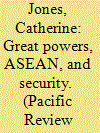

|
|
|
|
|
| Summary/Abstract |
The positive role that external powers can play in the creation and maintenance of security in regions has long been ignored; external interference is generally perceived as detrimental to the ability of a group of states to function as a community. However, this paper argues that in the case of ASEAN, the presence of external actors allows the group to function as a community that also provides and ensures security. This paper furthers the debate regarding ASEAN's security functions. With international attention focused on the Asia-Pacific, there is a need to understand the context in which security is maintained in Southeast Asia.
|
|
|
|
|
|
|
|
|
|
|
|
|
|
|
|
| 5 |
ID:
137210
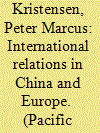

|
|
|
|
|
| Summary/Abstract |
The international relations (IR) discipline is known as an ‘American Social Science’ dominated by scholars and theories from the US core. This paper compares IR in two noncore settings, China and Europe. It shows that there is a growing institutional and intellectual integration into global Anglophone, mostly American, IR in both Europe and China. Both Chinese and European IR communities have established top Anglophone journals like the European Journal of International Relations and the Chinese Journal of International Politics to spearhead their integration into mainstream Anglophone IR and carve out a space for regional thinking. Yet, the analysis of their publication and citation patterns shows that IR outside the American core communicates through a hub-and-spokes system where there is always a connection to the American core but rarely very strong linkages to other peripheral regions. The two journals studied thus function as outlets for ‘local’ and American scholars, rely on ‘local’ and American sources, and there is very little integration and exchange between Chinese and European IR. Chinese and European IR would benefit from such a dialogue, especially regarding ‘schools’ of IR at the margins of an ‘American social science’.
|
|
|
|
|
|
|
|
|
|
|
|
|
|
|
|
| 6 |
ID:
137213
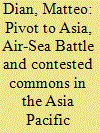

|
|
|
|
|
| Summary/Abstract |
The Pivot towards the Asia Pacific has been a key component of the grand strategy of the Obama administration. Militarily, the main challenge is represented by the Chinese capacity to erode the American ‘command of the commons’.
The United States have been developing a new operational concept, labelled ‘Air-Sea Battle’ (ASB) aimed at maintaining the capacity to project military power even if adversaries are able to deploy a sophisticated anti-access area denial strategy.
The implementation of ASB is likely induce Beijing to respond with a further acceleration of the process ofmodernisation of its armed forces.
|
|
|
|
|
|
|
|
|
|
|
|
|
|
|
|
| 7 |
ID:
137215
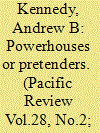

|
|
|
|
|
| Summary/Abstract |
Are China and India emerging as innovative technological powerhouses in the twenty-first century? This essay reviews the interdisciplinary debate that has been inspired by this question in recent years. It begins by considering recent studies that are relatively impressed with China's and India's recent accomplishments and potential in this regard. Next, it reviews works that are less impressed with their track records and prospects. It then considers a series of more equivocal studies that remain more or less undecided about China's and India's technological trajectories. The final section evaluates the debate as a whole and proposes new directions for scholarship in this field.
|
|
|
|
|
|
|
|
|
|
|
|
|
|
|
|
|
|
|
|
|